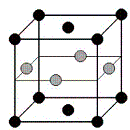Department of Physics and Astronomy: Publications and Other Research

Ralph Skomski Publications
Document Type
Article
Date of this Version
2009
Abstract
The effect of semihard magnetic phases and interfaces on the performance of nanostructured two-phase permanent magnets is investigated by model calculations. In addition to the trivial coercivity increase due to the replacement of soft regions by semihard regions, there is a coercivity enhancement even if the volume-averaged anisotropy is kept constant during the introduction of the semihard phase. A variational approach is used to derive analytical results for representative anisotropy profiles. The improvement is operative on length scales slightly larger than that of the soft phase in hard-soft composites, but the main challenge is to find semihard light or heavy transition metal phases with a high magnetization. There are several Fe- and Co-based phases, but most are thin-film systems and difficult to use in bulk magnets. Very hard nanostructured magnets may also be created from soft phases with negative but large anisotropy constants (hard-magnetic soft-soft magnets).


Comments
Published in JOURNAL OF APPLIED PHYSICS 105, 07A733 (2009). Copyright © 2009 American Institute of Physics. Used by permission.